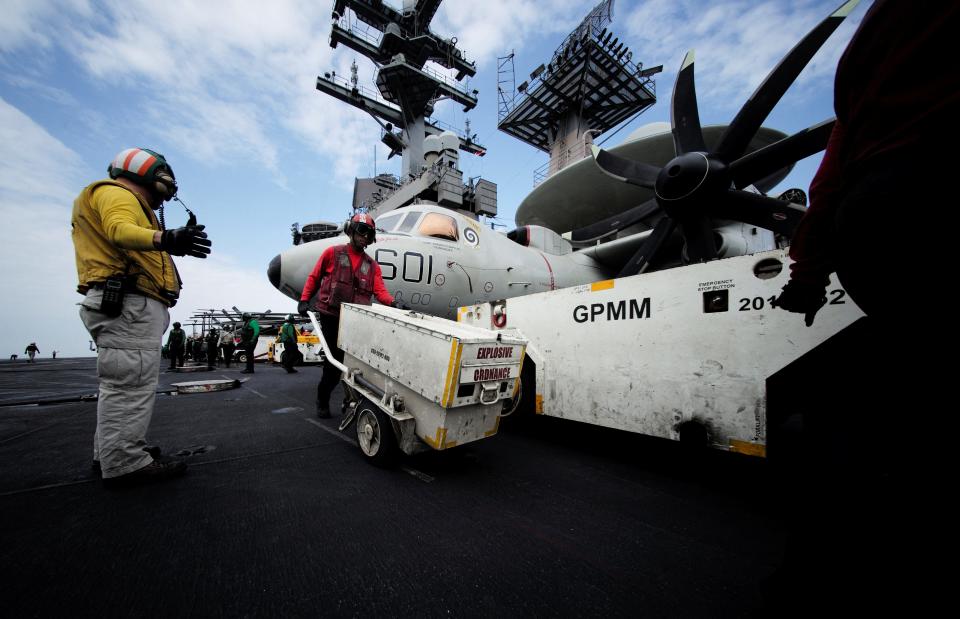A US Navy carrier strike group fired nearly 800 missiles and bombs during its Red Sea fight against the Houthis
The Dwight D. Eisenhower Carrier Strike Group just returned from battling the Houthis.
During its deployment, the strike group fired nearly 800 missiles and bombs, the Navy has revealed.
These include air- and ship-launched weapons used to take out Houthi threats.
US Navy warships and aircraft attached to a carrier strike group that spent months battling the Houthis fired off nearly 800 munitions during their restless Middle East deployment.
The new figures, released by the Navy last week, offer the most comprehensive and up-to-date tally of the missiles and bombs that the Dwight D. Eisenhower Carrier Strike Group expended while engaged in active combat operations against the Iran-backed rebels from November to June. The numbers also underscore the high intensity and growing cost of the counter-Houthi mission.
The Eisenhower strike group recently returned from its deployment, but another carrier, the Truman, and additional warships are replacing it.
During its deployment, the Eisenhower strike group — consisting of the aircraft carrier Ike, several destroyers, and a cruiser — fired 770 munitions as it worked to defend merchant shipping lanes in the Red Sea and Gulf of Aden from relentless Houthi attacks. This figure is over 250 munitions higher than what Navy officials disclosed in May, representing a significant jump in just a matter of weeks.

The warships launched 155 Standard surface-to-air missiles, used to intercept missiles or drones, and 135 Tomahawk missiles, used to hit targets on land, during the deployment. US forces frequently struck Houthi facilities, sites, and weapons in Yemen.
The carrier air wing, which was attached to the Ike and included F/A-18 Super Hornet fighters and EA-18 Growler jets, released 420 air-to-surface weapons and nearly 60 air-to-air missiles. These weapons were used to intercept aerial threats, destroy targets on the surface of the water, and strike Yemen. The air wing logged over 31,400 hours of flight time across nearly 14,000 sorties during the deployment.
"The Houthi targets in Yemen posed an immediate threat to US, coalition, and merchant shipping, and these strikes were designed to degrade Houthi offensive capabilities across more than 460 pre-planned, dynamic, and self-defense targets," the Navy said last week.
In its release, the Navy did not specify which air-launched munitions or how many of each ship-launched missile variant it fired, making it difficult to calculate the total cost of the weapons that the strike group expended. The Navy has identified some of the missiles it used in combat, although a total breakdown is unclear.

However, by mid-April, the Navy revealed that the strike group had already launched some $1 billion worth of missiles. It proceeded to fire several hundred more munitions in the following months, likely putting that figure notably higher.
The strike group returned to the US earlier this month, following what Navy officers and leaders described as an "unprecedented" and "historic" nine-month-long deployment. During the deployment, it faced a variety of threats in the region, including anti-ship cruise and ballistic missiles, one-way attack drones, and drone boats packed with explosives.
"When called upon, the force brought the fight to the Houthis in their front yard, linking airpower and dynamic and self-defense strikes," said Vice Adm. George Wikoff, the US 5th Fleet commander, in a statement last week as the Ike's deployment came to an end.
The commander stressed that "these acts reduced the risk to shipping and also reinforced our nation's commitment to maritime security."
Read the original article on Business Insider

